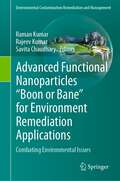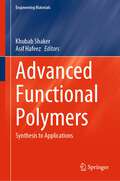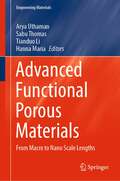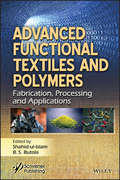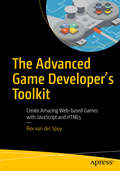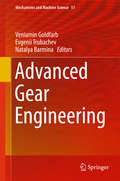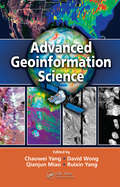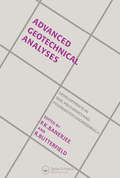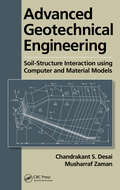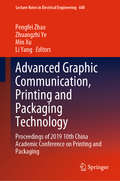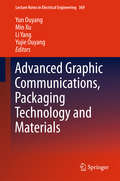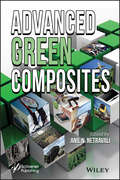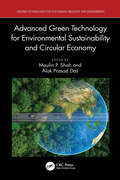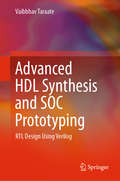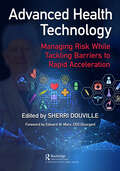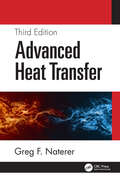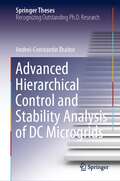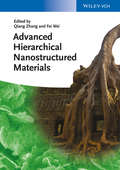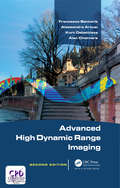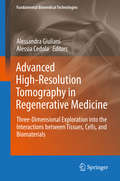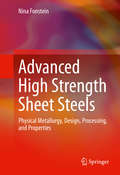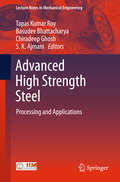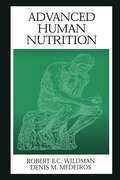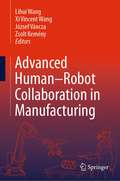- Table View
- List View
Advanced Functional Nanoparticles "Boon or Bane" for Environment Remediation Applications: Combating Environmental Issues (Environmental Contamination Remediation and Management)
by Raman Kumar Rajeev Kumar Savita ChaudharyThis textbook provides an overview of applications of advanced nanomaterials, basic lab set up and requirements in for their synthesis, techniques and career scope of nanotechnology in industries and research. Pollution of air, water, soil is an ever increasing environmental problem attributed to increasing population, global industrialization and unplanned urbanization, has acquired alarming dimensions. It is the most dangerous and worst problem that puts the lives of people, animals, and plants on the earth in danger. An effective, efficient and sustainable approach for managing pollution related problems requires the utmost attention of the scientific community to tackle this menace for the society to lead a healthy and quality life. A number of techniques and books, literatures have been developed in recent years to treat environmental contaminants. However, most of these are not economically viable, environmentally benign and suffer due to cumbersome multi-step manipulations. The purpose of this textbook is to inform students about the application of functionalized nanoparticles as a new approach to supplement traditional treatment methods in cost and time effective manner. The simplistic means to assemble nanoparticles to the constituents of next generation technologies in environment cleanup and sensing are the main objectives of the book. The toxicological footprinting of released advanced functional nanomaterials in ecosystem will also be discussed in the book.
Advanced Functional Polymers: Synthesis to Applications (Engineering Materials)
by Khubab Shaker Asif HafeezThis book highlights different domains of functional polymers from membranes and coatings to composite materials. It includes their synthesis routes and techniques, characterization, properties, and applications. The book also provides the basics and advances about different functional polymers and composites with an up-to-date progress in the field of research and their application on a domestic and industrial scale. The main topics to be covered include polymeric membranes, paints and coatings, smart polymers, self-healing elastomers, biodegradable polymers, food packaging, and functional composite materials.
Advanced Functional Porous Materials: From Macro to Nano Scale Lengths (Engineering Materials)
by Arya Uthaman Sabu Thomas Tianduo Li Hanna MariaThis book presents synthesis, characterization, and applications of macroporous, mesoporous, nanoporous, hierarchical porous, porous metals, and porous ceramics. Special emphasis is given to the preparation of porous activated carbon materials and porous ionic liquid-derived materials for CO2 emissions mitigation. Additionally, a chapter includes the physical and mathematical modeling in porous media. Many analytical techniques for characterization are discussed in this book. Also, the biomedical and industrial applications of porous materials in adsorption, catalysis, biosensors, drug delivery, nanotechnology are described. The content helps solving fundamental and applied problems in porous materials with length scales varying from macro- to nano-level.
Advanced Functional Textiles and Polymers: Fabrication, Processing and Applications
by Shahid-Ul-Islam B. S. ButolaThis book on advanced functional textiles and polymers will offer a comprehensive view of cutting-edge research in newly discovered areas such as flame retardant textiles, antimicrobial textiles, insect repellent textiles, aroma textiles, medical-textiles, smart textiles, and nano-textiles etc. The second part the book provides innovative fabrication strategies, unique methodologies and overview of latest novel agents employed in the research and development of functional polymers.
The Advanced Game Developer's Toolkit
by Rex van der Spuy<P>Master the most important skills and techniques you need to know for professional HTML5 and JavaScript 2D game development. This book delves into many of the great classic techniques of video game design. <P> You’ll discover how to develop games and game levels using Tiled Editor, how to implement tile-based collision, how to design advanced pathfinding and enemy AI systems, the fundamentals of broad-phase collision, and how to make isometric games. All the techniques and supporting code are explained in an easy-to-understand manner and written in a general way so that they can be applied to any game engine or technology that you’re comfortable using. <P> You'll find detailed working examples, with dozens of illustrations and many concepts you can freely apply to your own projects. All the math and programming techniques are elaborately explained and examples are open-ended to encourage you to think of original ways to use these techniques in your own games. You can use what you learn in this book as the basis for making games for desktops, mobile phones, tablets, or the Web. <P> The Advanced Game Developer's Toolkit is a great next step if you already have some JavaScript game-making- experience, or a great continuation if you've already read Advanced Game Design with HTML5 and JavaScript by the same author.
Advanced Gear Engineering (Mechanisms and Machine Science #51)
by Veniamin Goldfarb Natalya Barmina Evgenii TrubachevThis book covers recent developments in practically all spheres of mechanical engineering related to different kinds of gears and transmissions. Topics treated range from fundamental research to the advanced applications of gears in various practical fields, prospects of manufacturing development, results and trends of numerical and experimental research of gears, new approaches to gear design and aspects of their optimization synthesis.
Advanced Geoinformation Science
by Chaowei Yang David Wong Qianjun Miao Ruixin YangMany of the challenges of the next century will have physical dimensions, such as tsunamis, hurricanes, and climate change as well as human dimensions such as economic crises, epidemics, and emergency responses. With pioneering editors and expert contributors, Advanced Geoinformation Science explores how certain technical aspects of geoinformation
Advanced Geotechnical Analyses: Developments in Soil Mechanics and Foundation Engineering - 4
by P. K. Banerjee R. ButterfieldThe chapters in this book show that a careful blend of engineering judgement and advanced principles of engineering mechanics may be used to resolve many complex geotechnical engineering problems. It is hoped that these may inspire the geotechnical engineering practice to make more extensive use of them in future.
Advanced Geotechnical Engineering: Soil-Structure Interaction using Computer and Material Models
by Chandrakant S. Desai Musharraf ZamanSoil-structure interaction is an area of major importance in geotechnical engineering and geomechanics Advanced Geotechnical Engineering: Soil-Structure Interaction using Computer and Material Models covers computer and analytical methods for a number of geotechnical problems. It introduces the main factors important to the application of computer
Advanced Graphic Communication, Printing and Packaging Technology: Proceedings of 2019 10th China Academic Conference on Printing and Packaging (Lecture Notes in Electrical Engineering #600)
by Min Xu Li Yang Pengfei Zhao Zhuangzhi YeThis book includes a selection of peer-reviewed papers presented at the 10th China Academic Conference on Printing and Packaging, which was held in Xi'an, China, on November 14–17, 2019. The conference was jointly organized by the China Academy of Printing Technology, Beijing Institute of Graphic Communication, and Shaanxi University of Science and Technology. With 9 keynote talks and 118 papers on graphic communication and packaging technologies, the conference attracted more than 300 scientists.The proceedings cover the latest findings in a broad range of areas, including color science and technology, image processing technology, digital media technology, mechanical and electronic engineering, Information Engineering and Artificial Intelligence Technology, materials and detection, digital process management technology in printing and packaging, and other technologies. As such, the book appeals to university researchers, R&D engineers and graduate students in the graphic arts, packaging, color science, image science, material science, computer science, digital media, and network technology.
Advanced Graphic Communications, Packaging Technology and Materials (Lecture Notes in Electrical Engineering #369)
by Min Xu Li Yang Yun Ouyang Yujie OuyangThis book includes a selection of reviewed papers presented at the 2015, 4th China Academic Conference on Printing and Packaging, which was held on October 22-24, 2015 in Hangzhou, China. The conference was jointly organized by the China Academy of Printing Technology, Beijing Institute of Graphic Communication, and Hangzhou Dianzi University. With 3 keynote talks and 200 presented papers on graphic communications, packaging technologies and materials, the conference attracted more than 400 scientists. These proceedings cover the recent research outcomes on color science and technology, image-processing technology, digital-media technology, printing-engineering technology, packaging-engineering technology etc. They will be of interest to university researchers, R&D engineers and graduate students in graphic communications, packaging, color science, image science, materials science, computer science, digital media and network technology fields.
Advanced Green Composites
by Anil N. NetravaliMost composites, particularly those made using thermoset resins, cannot be recycled or reused. As a result, most of them end up in landfills at the end of their useful life which is neither sustainable nor environment-friendly. Various laws enacted by Governments around the world and heightened global awareness about sustainability and global warming is changing this situation. Significant research is being conducted in developing and utilizing sustainable fibers and resins, mostly derived from plant, to fabricate ‘Green’ composites. The significant progress in the past 20 or so years in this field has led to the development of green composites with high strength or so called Advanced Green Composites. More interestingly, green composites have also acquired various different properties such as fire resistance, transparency, barrier to gases and others. The term ‘advanced’ which only included high strength and stiffness now includes all these special properties. The world is on the cusp of a major change, and once fully developed, such composites could be used in applications ranging from automobiles to sporting goods, from circuit boards to housing and from furniture to packaging. This book, by presenting the state-of-the-art developments in many aspects of advanced green composites adds significantly to the knowledge base that is critical for their success of expanding their use in applications never seen before. The chapters are written by world’s leading researchers and present in-depth information in a simple way. This provides readers and researchers the latest developments in the field of ‘Green’ resins (with ways of strengthening them), High Strength Green Fibers (including micro and nano-cellulose fibrils/fibers) and Green Composites in the first few chapters. The introductory chapter summarizes the consequences of using conventional, petroleum-based materials and the need for green composites as well as the progress being made in this field. After that the book delves in to Advanced Green Composites in a broader sense and includes chapters on High Strength Green Composites, Self-healing Green Composites, Transparent Green Composites, All-cellulose composites, Toughened Green Composites, Green Biofoams, Bioinspired Shape Memory Composites, etc. The chapters are written by the experts who are highly respected in their fields.
Advanced Green Technology for Environmental Sustainability and Circular Economy (Greener Technologies For Sustainable Industry And Environment)
by Maulin P. Shah Alok Prasad DasThis book elucidates the growing application of greener technology with a circular economic approach and examines the connection among environment, economy, and ecology for an emerging and supportable human society. It focuses on numerous features of environmental sustainability and, more responsibly, labels the technologies and methods essential to overcome growing environmental challenges, including biotechnological methods, cutting-edge research, applications, and procedures.Features: Proposes the latest advances in waste treatment, pollution reduction, and circular economy development based on green technology. Considers the relationship between green technological progress and various forms of circular economy. Describes resource recycling and recovery. Covers advanced technology in bioremediation. Includes reports and case studies highlighting the "how-to" on waste-to-energy generation. This book is aimed at professionals and graduate students in environmental engineering, project management, bioremediation, sustainable development, and waste management.
Advanced HDL Synthesis and SOC Prototyping: Rtl Design Using Verilog
by Vaibbhav TaraateThis book describes RTL design using Verilog, synthesis and timing closure for System On Chip (SOC) design blocks. It covers the complex RTL design scenarios and challenges for SOC designs and provides practical information on performance improvements in SOC, as well as Application Specific Integrated Circuit (ASIC) designs. Prototyping using modern high density Field Programmable Gate Arrays (FPGAs) is discussed in this book with the practical examples and case studies. The book discusses SOC design, performance improvement techniques, testing and system level verification, while also describing the modern Intel FPGA/XILINX FPGA architectures and their use in SOC prototyping. Further, the book covers the Synopsys Design Compiler (DC) and Prime Time (PT) commands, and how they can be used to optimize complex ASIC/SOC designs. The contents of this book will be useful to students and professionals alike.
Advanced Health Technology: Managing Risk While Tackling Barriers to Rapid Acceleration
by Sherri DouvilleEverything worth winning in life boils down to teamwork and leadership. In my positions as a businessman, athlete, community leader, and University trustee, there are tremendous parallels between all of these endeavors that mirror an extreme team sport such as medical technology. Understanding the game, defining the game, playing your position at your highest performance, and helping others play their best game. Advanced Health Technology represents an incredible opportunity to level up the game of healthcare and highlights the multiple disciplines – or positions to be mastered – while laying out winning plays to make that next level happen. Ronnie Lott, Managing Member, Lott Investments; Member, Pro Football Hall of Fame, and Trustee, Santa Clara University Healthcare stakeholders are paralyzed from making progress as risks explode in volume and complexity. This book will help readers understand how to manage and transcend risks to drive the quadruple aim of improved patient experiences, better patient and business outcomes, improved clinician experience, and lower healthcare costs, and also help readers learn from working successful examples across projects, programs, and careers to get ahead of these multidisciplinary healthcare risks.
Advanced Heat Transfer
by Greg F. NatererThe book provides a valuable source of technical content for the prediction and analysis of advanced heat transfer problems, including conduction, convection, radiation, phase change, and chemically reactive modes of heat transfer. With more than 20 new sections, case studies, and examples, the Third Edition broadens the scope of thermal engineering applications, including but not limited to biomedical, micro- and nanotechnology, and machine learning. The book features a chapter devoted to each mode of multiphase heat transfer. FEATURES Covers the analysis and design of advanced thermal engineering systems Presents solution methods that can be applied to complex systems such as semi-analytical, machine learning, and numerical methods Includes a chapter devoted to each mode of multiphase heat transfer, including boiling, condensation, solidification, and melting Explains processes and governing equations of multiphase flows with droplets and particles Applies entropy and the second law of thermodynamics for the design and optimization of thermal engineering systems Advanced Heat Transfer, Third Edition, offers a comprehensive source for single and multiphase systems of heat transfer for senior undergraduate and graduate students taking courses in advanced heat transfer, multiphase fluid mechanics, and advanced thermodynamics. A solutions manual is provided to adopting instructors.
Advanced Hierarchical Control and Stability Analysis of DC Microgrids (Springer Theses)
by Andrei-Constantin BraitorThis book introduces several novel contributions into the current literature. Firstly, given that microgrid topologies are paramount in theoretical analysis, the author has proposed a rigorous method of computing the network’s admittance matrix and developed to facilitate the stability analysis of DC microgrids supplying nonlinear loads. This unique approach enabled the factorisation of the admittance matrix in a particular way that facilitates a rigorous theoretical analysis for deriving the stability conditions.Secondly, author has proposed a unified control structure at the primary control layer that maintains the widely accepted droop-based approaches and additionally ensures crucial current- and voltage-limiting properties, thus offering an inherent protection to distributed energy resources. He has formalised the control design proofs using Lyapunov methods and nonlinear ultimate boundedness theory, for both parallel and meshed microgrid configurations. Moreover, he has developed a distributed secondary controller using a diffusive coupling communication network, on top of the primary control, to achieve voltage restoration and improve the power sharing. In this way, the author has formulated the complete hierarchical control scheme.In this high-order nonlinear setting, he has analytically proven closed-loop system stability of the overall system, for the first time, using two-time scale approaches and singular perturbation theory, by formulating rigorous theorems that introduce straightforward conditions that guide the system and control design and demonstrate system stability at the desired equilibrium point. In addition, the author has provided a straightforward algorithm for simple testing of system stability and explored from a graphical perspective by giving an interpretation to the effect of the nonlinear load onto the system performance and stability.
Advanced Hierarchical Nanostructured Materials
by Qiang Zhang Fei WeiAn overview of the recent developments and prospects in this highly topical area, covering the synthesis, characterization, properties and applications of hierarchical nanostructured materials. The book concentrates on those materials relevant for research and development in the fields of energy, biomedicine and environmental protection, with a strong focus on 3D materials based on nanocarbons, mesoporous silicates, hydroxides, core-shell particles and helical nanostructures. Thanks to its clear concept and application-oriented approach, this is an essential reference for experienced researchers and newcomers to the field alike.
Advanced High Dynamic Range Imaging: Theory And Practice
by Francesco Banterle Alessandro Artusi Kurt Debattista Alan ChalmersThis book explores the methods needed for creating and manipulating HDR content. HDR is a step change from traditional imaging; more closely matching what we see with our eyes. In the years since the first edition of this book appeared, HDR has become much more widespread, moving from a research concept to a standard imaging method. This new edition incorporates all the many developments in HDR since the first edition and once again emphasizes practical tips, including the authors' popular HDR Toolbox (available on the authors' website) for MATLAB and gives readers the tools they need to develop and experiment with new techniques for creating compelling HDR content. Key Features: Contains the HDR Toolbox for readers' experimentation on authors' website Offers an up-to-date, detailed guide to the theory and practice of high dynamic range imaging Covers all aspects of the field, from capture to display Provides benchmarks for evaluating HDR imagery
Advanced High-Resolution Tomography in Regenerative Medicine: Three-Dimensional Exploration into the Interactions between Tissues, Cells, and Biomaterials (Fundamental Biomedical Technologies)
by Alessandra Giuliani Alessia CedolaThis book covers the state-of-the-art research on advanced high-resolution tomography, exploring its role in regenerative medicine. and also explores the 3D interactions between tissues, cells, and biomaterials. Various multidisciplinary paths in regenerative medicine are covered, including X-ray microtomography and its role in regenerative medicine, synchrotron radiation-based microtomography and phase contrast tomography, the challenge of the vascularization of regenerated tissues, lung and cartilage imaging, and more. This is an ideal book for biomedical engineers, biologists, physicists, clinicians, and students who want to pursue their studies in the field of regenerative medicine.This book also:Reviews in detail the algorithms and software used for the 3D exploration of regenerated tissueCovers the latest research on the use of X-ray microtomography for muscle diseasesDetails applications of synchrotron radiation tomography in orthopedics and dentistry
Advanced High Strength Sheet Steels: Physical Metallurgy, Design, Processing, and Properties
by Nina FonsteinThe book covers all types of advanced high strength steels ranging from dual-phase, TRIP. Complex phase, martensitic, TWIP steels to third generation steels, including promising candidates as carbide free bainitic steels, med Mn and Quenching & Partitioning processed steels. The author presents fundamentals of physical metallurgy of key features of structure and relationship of structure constituents with mechanical properties as well as basics of processing AHSS starting from most important features of intercritical heat treatment, with focus on critical phase transformations and influence of alloying and microalloying. This book intends to summarize the existing knowledge to show how it can be utilized for optimization and adaption of steel composition, processing, and for additional improvement of steel properties that should be recommended to engineering personal of steel designers, producers and end users of AHSS as well as to students of colleges and Universities who deal with materials for auto industry.
Advanced High Strength Steel: Processing and Applications (Lecture Notes in Mechanical Engineering)
by Tapas Kumar Roy Basudev Bhattacharya Chiradeep Ghosh S. K. AjmaniThis volume comprises select proceedings of the AHSS 2017 conference. AHSS is an instrumental event in creating a platform for exchanging recent thoughts and results among a selective group of researchers working in the area of steel science and engineering. Twenty two selected papers have been included in this volume. This book will serve as a reference to many practitioners and researchers working in the areas of steel strength, characterization, and applications.
Advanced High Voltage Power Device Concepts
by B. Jayant BaligaThe devices described in "Advanced MOS-Gated Thyristor Concepts" are utilized in microelectronics production equipment, in power transmission equipment, and for very high power motor control in electric trains, steel-mills, etc. Advanced concepts that enable improving the performance of power thyristors are discussed here, along with devices with blocking voltage capabilities of 5,000-V, 10,000-V and 15,000-V. Throughout the book, analytical models are generated to allow a simple analysis of the structures and to obtain insight into the underlying physics. The results of two-dimensional simulations are provided to corroborate the analytical models and give greater insight into the device operation.
Advanced Human Nutrition (Modern Nutrition)
by Robert E.C. Wildman Denis M. MedeirosThis text begins with an in-depth overview into the human organism at the molecular, cellular, tissue and organ levels, and develops into a discussion of the objectives and features of organ systems of the evolved human. The book also covers the relationship between the human body and the environment in which it exists including other organisms tha
Advanced Human-Robot Collaboration in Manufacturing
by Lihui Wang Xi Vincent Wang József Váncza Zsolt KeményThis book presents state-of-the-art research, challenges and solutions in the area of human–robot collaboration (HRC) in manufacturing. It enables readers to better understand the dynamic behaviour of manufacturing processes, and gives more insight into on-demand adaptive control techniques for industrial robots.With increasing complexity and dynamism in today’s manufacturing practice, more precise, robust and practical approaches are needed to support real-time shop-floor operations. This book presents a collection of recent developments and innovations in this area, relying on a wide range of research efforts.The book is divided into five parts. The first part presents a broad-based review of the key areas of HRC, establishing a common ground of understanding in key aspects. Subsequent chapters focus on selected areas of HRC subject to intense recent interest. The second part discusses human safety within HRC. The third, fourth and fifth parts provide in-depth views of relevant methodologies and algorithms. Discussing dynamic planning and monitoring, adaptive control and multi-modal decision making, the latter parts facilitate a better understanding of HRC in real situations. The balance between scope and depth, and theory and applications, means this book appeals to a wide readership, including academic researchers, graduate students, practicing engineers, and those within a variety of roles in manufacturing sectors.
